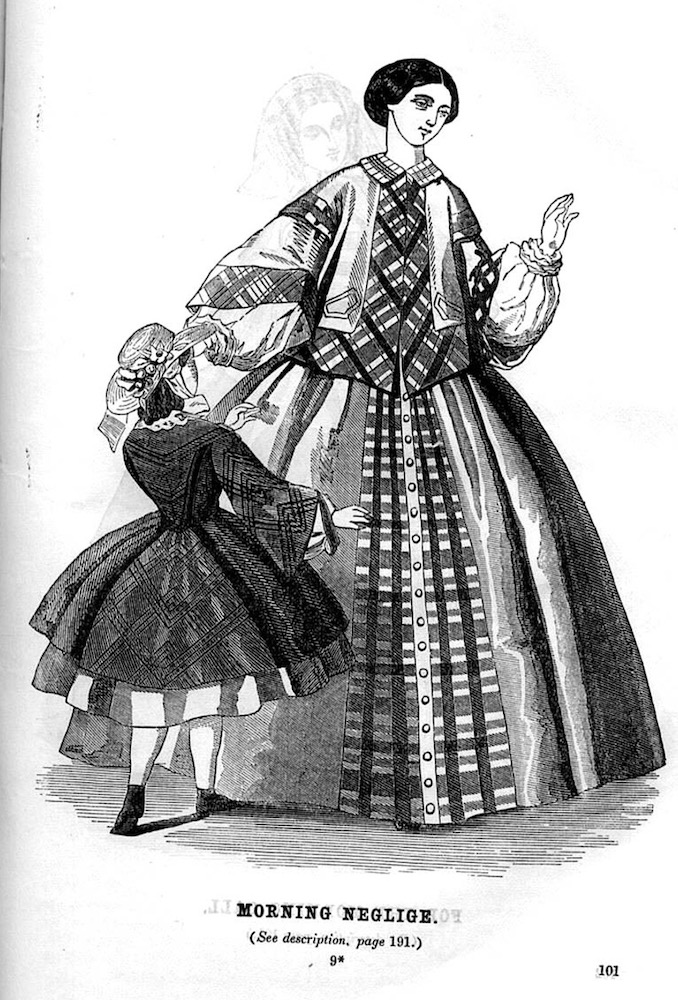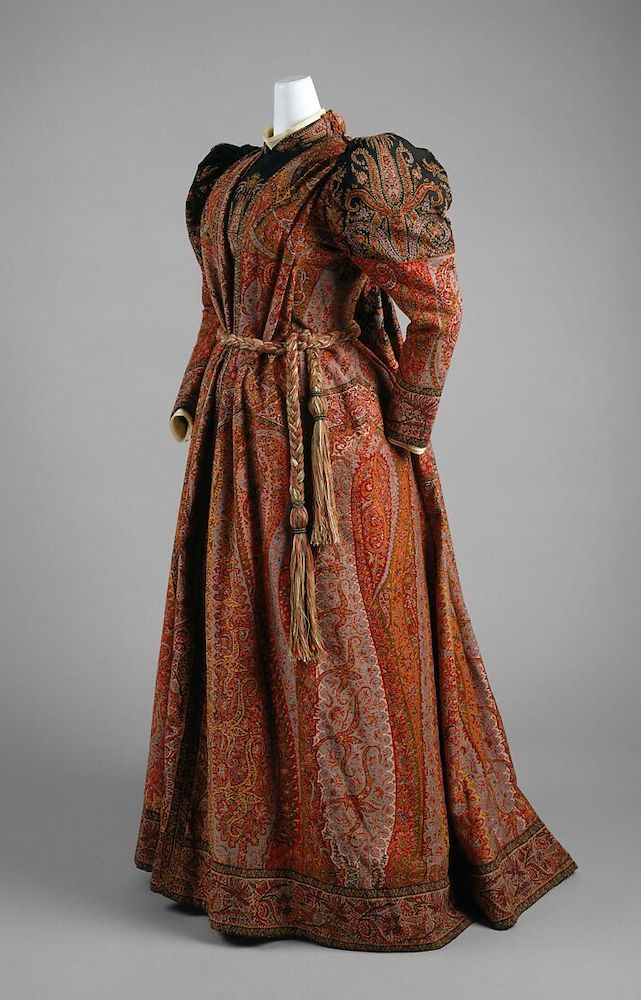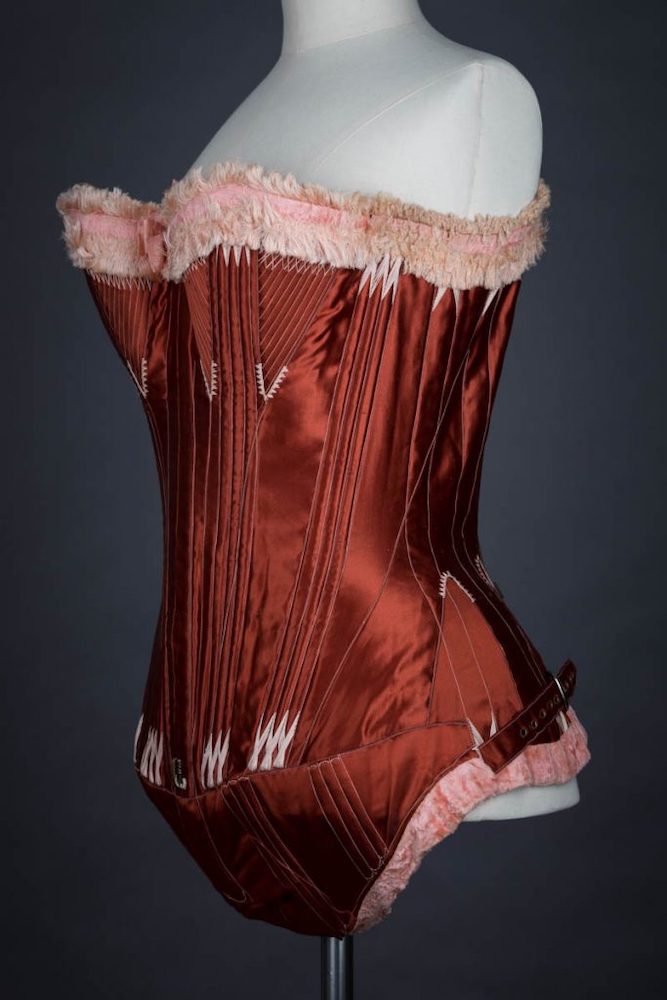This article has been peer-reviewed under the direction of Professors Mary Elizabeth Leighton and Lisa Surridge (University of Victoria). It forms part of the Great Expectations Pregnancy Project, funded by the Social Sciences and Humanities Research Council of Canada. [Click on the images to enlarge them.]
The modern popular narrative of Victorian pregnancies is that women hid away from the world for the sake of decency, their bodies showing the literal embodiment of sex. This perception is furthered by the idea that women did not require fashionable dress for the duration of their gestation. This popular view assumes that women did not play important and visible roles within their families or, indeed, in the economy or society. While it is true that the expected trajectory for many women's lives was to become wives and mothers, they were also often responsible for domestic management and caring for children, as well as having, in many cases, employment both in and out of the home — including the unpaid labour of running a house. However, it is also true that, before reliable birth control, most women spent a significant portion of their adult lives either pregnant or rearing children (Fisk 404). Despite the dominant discourse of Victorian women's invisibility during pregnancy, extant dress artefacts show that they were in fact visible and, indeed, dressed to the sartorial standards of the day through fashionable maternity garments. These artefacts are less plentiful in collections than clothing for other major life events such as weddings or mourning, due to being altered after use (Shonefield, 1972). This lack of extant items, and advertising that delicately circumvented the topic of pregnancy, contributes to the false notion that women had no need for fashionable maternity clothes because they were not publicly pregnant.
The Victorian woman had a societally imposed divine duty to bear children, and indeed sex was viewed as being solely for the purpose of reproduction, within the institution of marriage (Stone and Sanders 99). The multiple pregnancies that women endured had negative effects on their bodies. The risk of death for both mother and child before, during, and after birth was high (Stone and Sanders 100). This risk meant that women endured not only the physical and emotional effects of pregnancy but also the possible emotional and psychological effects of grief and fear. And for the small number of specifically upper-class women who spent their final trimester at home, there was a sense of isolation that could contribute to feelings of depression (Stone and Sanders 103). Prior to imposed medical intervention in the late nineteenth century, births took place in the home with female midwives, who had centuries' worth of inherited knowledge to safely deliver children (Stone 154). However, with the increase in births taking place in clinical environments — with male clinicians, a lack of understanding of germs and infection, and potentially dangerous anestheticsthere was an increase in deaths during and immediately after childbirth, particularly among upper- and middle-class women.
Maternity dresses, particularly in the early years of the Victorian period, were regular dresses that were altered to accommodate the changing body (Wilson 151). As the period progressed, separates and tea gowns (loose-fitting gowns inspired by Aesthetic dress) were more commonly worn, which better accommodated the expanding stomach of the wearer (see also "Tea Gown"). The second half of the nineteenth century saw expanding industries and rapid increases in production, which also included the mass availability of sewing machines. Sewing machines increased factory production and made it easier for women to sew clothing at home (Putnam, 277). They also afforded middle-class women the opportunity for more clothing options, including clothing made for maternity purposes. One of these garments that was made especially for pregnancy and nursing, the maternity corset, is one of the most misunderstood garments of the period. Maternity corsets are often used as an example of how nefarious the garments were, and they are often blamed for a decline in the birth rate, under the assumption that women continued to wear tightly fitting corsets throughout their pregnancies (Steele 59). However, maternity corsets were designed to provide support, rather than compression, invalidating these arguments that associate the decline of society with women and their dress.
Alterations: 1830s to 1860s


Left: 1840s dress. Courtesy Metropolitan Museum of Art. Right: 1840s dress, showing signs of alterations.
Before textiles and clothing were produced on a large industrial scale in the final decades of the Victorian period, the cost and life cycle of fabrics meant that clothing used exclusively during pregnancy seemed expensive and unnecessary (Fisk, 407). Instead, dresses were altered and adapted during pregnancy and then altered again once the body adjusted, postpartum. Because childbearing was such a significant part of the lives of women, they integrated the cycle of pregnancy and birth into their wardrobes (Fisk 407). Dresses in this period, especially those meant to be worn exclusively in domestic spaces, were made with the intention of being modified (Fisk 415). In the 1840s and '50s, many dress bodices featured diagonal pleating, called "fan pleating," down the fronts of the bodice. These pleats were gathered at the waist with a drawstring, which allowed the volume of the pleats to be released (depicted on the left), expanding the size of the bodice without much further alteration required (O'Brien 502). As well as permitting easy alteration, these pleats also provided places to hide slits at the bust to make breastfeeding more accessible (Fisk 407).
Skirts and petticoats were modified to be longer in the front than the back, again to accommodate the growing abdomen. This ingenuity can be seen in a dress from the 1840s housed in the Fashion Archives and Museum of Shippensburg University, in Pennsylvania, which shows signs of these alterations (depicted on the right above). Where there was no room for alterations in pleated bodices, darts could be let out and lacing temporarily added at the side seams with a modesty panel. The modesty panel was an added piece of fabric, often matching the dress, which was placed behind lacing to hide the underpinnings beneath, ensuring that the lacing did not reveal what was under the dress (Fisk 415).
Transitions: 1860s to 1900s



Left to right: (a) Fashionable Maternity Gown, 1882. Courtesy the Metropolitan Museum of Art. (b) Brown maternity dress with alterations, 1880. Wikimedia Commons. (c) Box Jacket, Godey's Lady's Book, 1859.
With the increase in factory production, the ease of home sewing, as well as further advances in fashion and consumerism, garments made specifically for maternity wear were increasingly available in the last four decades of the century, albeit not advertised as such (O'Brien 502). The presence of these fashionable maternity dresses (see above left) provides evidence against the idea that women were hidden away (Fisk 428). By the 1860s, fashion had changed from dresses with attached bodices to skirts and separate bodices. These bodices included garments that were made of a separate material from the skirt, such as shirtwaists, or full outfits that had different bodices for day and evening wear. This new modular wardrobe accommodated alterations for maternity wear. Box jackets (depicted above right), for example, were cut full and did not closely follow the lines of the body, accommodating the growth of pregnancy (O'Brien 502).

Tea Gown, 1891. Courtesy of the Metropolitan Museum of Art.
Another garment that was popular in the last twenty-five years of the Victorian era that was a blessing for the expectant and fashionable mother was the tea gown (depicted on the right). Originally inspired by Aesthetic dress, it grew in popularity throughout the 1870s and 1880s (Wahl xix). The tea gown was initially intended to be worn by women at home during afternoon teatime, though it was eventually worn on other occasions (Wahl 146). The benefit of this gown was that it was loose-fitting and did not require a corset (Rieger 259). Because this gown was intended to be worn in the house and could easily be worn prior to and throughout pregnancy, it allowed the expectant mother to receive guests while being fashionable and comfortable (Rieger 261). The tea gown was so ubiquitous as a garment worn during pregnancy that many novels used it as a plot device when a woman character is expecting (Rieger 262).
Fashion in Periodicals
Concurrent with increased fashion production, the Victorian era also saw an increase in literacy and therefore the advent of specialized periodicals, including those for women. These magazines offered fashion advice, included dress patterns, and were filled with advertising. Publications worked within the societal norms and constraints of the period, meaning they had to use discretion around gestation (Summers 41). While these periodicals did not explicitly describe maternity clothing, they used language and images that hinted at it (O'Brien 502). In one example from The Lady's Friend (1867), a woman is shown in a box jacket, sitting at a writing desk (FiskAes 402). The image is ambiguous in not showing the woman from the front, hinting at the possibility that the woman in the illustration is expecting. Garments such as this served a dual purpose, of at-home morning wear and maternity wear. It was not until the early twentieth century that companies made and advertised maternity clothing. In 1904, American clothing company Lane Bryant claimed to be the first company to manufacture dresses explicitly for maternity wear that were not intended to be altered afterward (Rieger 2014). Indeed, even the advertisements for maternity corsets used ambiguous language, with references to products catering to married women, with all the implications that only married women were permitted to be sexually active (Summers 41).
Corsets and Pregnancy
Though fashions changed throughout the decades of the Victorian era, there was one sartorial constant: corsets. They are a largely misunderstood, and often villainized, component of the dress of women (and indeed men), especially with regard to pregnancy (Steele 56). The narrative that corsets have a negative effect on pregnancy has been repeated ad infinitum by nearly any scholar who has touched upon the topic of corsets or Victorian womanhood. One of the reasons for this strong and pervasive narrative is that there was a marked decline in the birthrate in the second half of the nineteenth century (Davies 1982). The reason for this decline, according to contemporary critics of nineteenth-century dress, was not the shift to an increasingly medicalized environment for birth (Stone 154), nor was it attributed to toxins in the environment, lead in cosmetics, better education around family planning, more reliable contraception, or even the increased urban population that no longer relied on many children for farm work (McKnight 10). Instead, the reason given by these Victorian critics for the decline in the birth rate was the use of corsets. Doctors and social commentators lamented that women refused to remove their corsets during pregnancy and that this affected not only the potential health of the child, but also the woman's future fertility (Kelly 5). The attitude of many Victorian doctors toward women was often misogynistic and tinged with eugenicist and Darwinian sentiments about maintaining a strong white middle class (McKnight 12). Such doctors and critics blamed women for being more concerned about their appearance than their health and the health of their progeny.
Critics of fashion stated, and continue to state, that corsets "impaired the healthy function of women's digestive, circulatory, and reproductive systems" (Kelly 2). They expressed concern that the pressure put on the body would negatively affect the growing fetus. As Leigh Summers astutely notes, however, the fetus "until the last trimester was cushioned from immediate pressure by amniotic fluid [but] this apparent and rudimentary observation was completely ignored by the garment's critics" (Summers 44). Furthermore, women were expected to be in a near-constant state of pregnancy, which had adverse effects similar to the concerns of corset critics, including an increased cardiac output, elevated diaphragm, the subcostal angle of the ribs increasing by forty degrees, reduced lung capacity, and organ displacement from the expanding uterus (McKnight 12).

Maternity Corset, 1880. Courtesy of the Underpinnings Museum.
Another issue that critics of corsets have chosen to ignore is the existence of maternity corsets. The primary way in which corsets and pregnancy have been perceived for the past 170 years incorrectly assumes that women wore one corset throughout their pregnancy and, indeed, that every Victorian woman practiced tightlacing. It was not until an expectant mother first felt the "quickening," the first movements of the fetus, that pregnancy was confirmed, and women discarded their regular corsets for a maternity corset (Stone and Sanders 101). However, even before the adoption of specialty corsets, the benefit of regular corsets was that they could be loosened as the body grew. Maternity corsets were specially made to accommodate the requirements of the pregnant and postpartum body. Laces, buttons, directional use of boning, additional abdominal support (depicted on the left), and elastic panels all helped create support (Fisk 427). Rather than add pressure to create an ideal shape, maternity corsets were designed to support and lift the growing abdomen, much like modern belly-bands. Postpartum snapped flaps at the bust gave access for breastfeeding (Fisk 427). Critics of pregnancy and corsets may have inadvertently created a self-fulfilling prophecy, as the medical warnings may have been heard by some women who did not want to be pregnant. It is possible that some women used a tight corset to try to terminate their pregnancy (Steele 76), thus taking agency over their bodies in a society that would see them always already pregnant.
Conclusion
Because of the frequency of pregnancies for most women, prior to the availability of the home sewing machine, women's clothing was made with the option to alter it, through draw-string gathers and removable darts. The styles then went from utilitarian to more elaborate gowns made of rich materials, with substantial trimmings (Shonfield 37). The increased fashionability of the tea gown afforded pregnant women comfort and style while their bodies grew throughout gestation. And for those women who continued to wear corsets, the extra support to the belly that corsets provide relieved some of the weight and discomfort in the final stages of pregnancy. When the material evidence is examined, it becomes clear that Victorian women indeed wore fashionable maternity clothing.
Links to Related Material
- What Victorians Wore (sitemap)
- Aesthetic Dress and the Rational Dress Society
- Victorian Constraints: A review of Undressed: A Brief History of Underwear at the Victoria and Albert Museum, 2016/17
Bibliography
Davis, Mel. "Corsets and Conception: Fashion and Demographic Trends in the Nineteenth Century." Comparative Studies in Society and History 24:4 (October 1982): 611641.
Fisk, Catronia. "Looking for Maternity: Dress Collections and Embodied Knowledge." Fashion Theory 23:3 (2019): 40139.
Kelly, Lori Duin. "Crossing the 'Bearing' Straits: Women's Maternity Dress in the 19th Century." Studies in Popular Culture 21:1 (October 1998): 112.
McKnight, Alanna. "The Kurious Kase of Kim Kardashian's Korset." Fashion Studies 3:1 (2020): 120.
O'Brien, Alden. "Maternity Dress." Berg Companion to Fashion. Ed. Valerie Steele. Oxford: Berg, 2010: 50103.
Putnam, Tim. "The Sewing-Machine Comes Home" in The Culture of Sewing: Gender, Consumption and Home Dressmaking. Ed. Barbara Burman. Oxford: Berg Press, 1999.
Rieger, K. Irene. "Garment No. 5: The New Woman Novel and the First Maternity Clothes." CEA Critic 76:3 (November 2014): 25966.
Shonfield, Zuzanna. "The Expectant Victorian (Late 19th Century Maternity Clothes)." Costume. 6:1 (1972): 3642.
Steele, Valerie. Corsets: A Cultural History. New Haven: Yale University Press, 2001.
Stone, Pamela K. "Biocultural Perspectives on Maternal Mortality and Obstetrical Death From the Past to the Present." The American Journal of Physical Anthropology. 159:S61 (2016): 15071.
Stone, Pamela K., and Lise Shapiro Sanders. Bodies and Lives in Victorian England: Science, Sexuality, and the Affliction of Being Female. London: Routledge, 2021.
Summers, Leigh. Bound to Please: A History of the Victorian Corset. Oxford: Berg, 2001.
Wahl, Kimberly. Dressed as in a Painting: Women and British Aestheticism in the Age of Reform. Durham: University of New Hampshire Press, 2013.
Wilson, Kathryn. "Commodified Craft, Creative Community: Women's Vernacular Dress in Nineteenth-Century Philadelphia" in The Culture of Sewing: Gender, Consumption and Home Dressmaking. Ed. Barbara Burman. Oxford: Berg Press, 1999.
Created 2 May 2023
